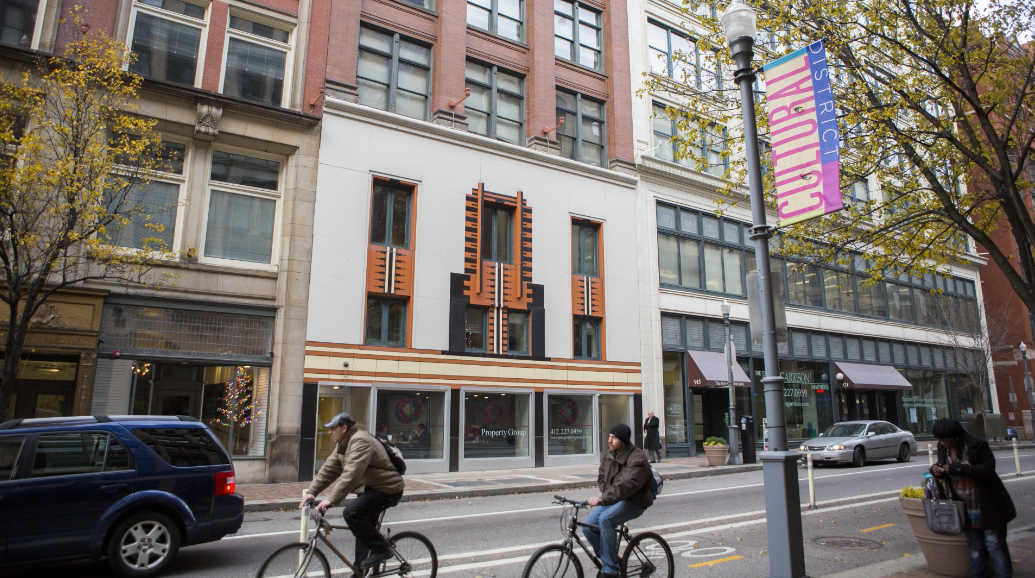In a dense downtown, making a neighborhood
Listen
The Cultural District in Pittsburgh (Jessica Kourkounis/for Keystone Crossroads)
As more people are moving into dense urban areas, how do cities ensure these neighborhoods thrive?
In 1989, five-year-old Jessica Fink visited Pittsburgh with her family. Although she grew up less than an hour away, in West Virginia, it was her first time visiting the city. “Whenever we came through the tunnels,” she says. “I saw the city for the first time, and I was just blown away, I couldn’t believe what I was seeing. It was like seeing another world.”
Fink quickly made up her mind — this was her future. She told her parents right then that she was going to move to downtown Pittsburgh one day. “My dad glanced in the rear view mirror, looking at me and they laughed,” she said. ” And he’s like, ‘Honey, nobody lives in downtown. You might work down here, but nobody lives down here. It’s just offices and some factory stuff.'”
In 2013, Fink finally moved to downtown Pittsburgh. She was joined by many. A new report shows that the population of greater downtown Pittsburgh — an area that includes the Central Business District as well as bordering neighborhoods like the Strip District, Uptown, Lower Hill, North Shore, and South Shore — has grown by 20 percent since 2010. The Pittsburgh Downtown Partnership says that around 15,000 people live in that area, the most in 60 years.
What has driven the population growth?
Following the Second World War and up and through the early 1990s, there was a migration of middle and upper classes for the suburbs. Cities, realizing that they were dying, decided to start building major civic projects in their downtowns. Ken Schroeppel, a professor of urban planning at University of Colorado-Denver, says those investments were key to today’s boom.
“A lot of cities went through the whole stadium, arena, convention center, museum, library kind of wave of development, largely focused in the urban core, as part of a broader strategy of allowing the center city to come back and be revitalized,” he says. “What was kind of key to a lot of these investments was urban tourism.”
Denver has been a notable success, now counting 73,000 residents in its greater downtown, but cities like Pittsburgh are following its lead. During the 1990s and 2000s, the city saw a wave of development: PNC Park, Heinz Field, and the new convention center were built, and Market Square and the Cultural District were renovated.
People started coming downtown for more than just their office jobs — they came to see a game or a show, and would grab dinner before or drinks after. Essentially, the megaprojects created the conditions to allow bars and restaurants to take off. People started having fun in downtowns; ultimately, some of them wanted to move there.
“That has fundamentally changed the way the city functions,” says Jeremy Waldrup, the CEO and president of the Pittsburgh Downtown Partnership. “People are out on the streets later. You have folks walking dogs at 11 p.m., you see strollers kind of walking through downtown. Ten years ago, you’d be hard-pressed to find those.”
That growth shows no sign of stopping — according to the PDP, another 3,400 residential units are in the development pipeline.
What’s next?
Even lovers of urban life, like Fink and Waldrup, admit that downtown Pittsburgh still has a ways to go. The area is walkable and has plenty of restaurants, but there still aren’t many retail outlets, green space is at a minimum, and there are few entertainment for families. Fink says: “If they could make it more family-friendly, more like, maybe a little park with like a little playground.”
But the biggest complaint about downtown Pittsburgh is a lack of a grocery store. This is something that Jeremy Waldrup, with the downtown partnership, hears constantly. “Folks still want a Giant Eagle, a Whole Foods, a Trader Joe’s,” he says. “We hear from them a lot.”
According to Waldrup, grocers and retailers are interested in downtown Pittsburgh, but they just need to find the right spaces. Once again, Denver can serve as a promising example: Last year, after years of demand, that city’s first downtown grocery store finally opened. And now, just a block away from there, a second is under construction.
So, Pittsburgh grocery stores: Here’s a notice. You’re wanted downtown.
WHYY is your source for fact-based, in-depth journalism and information. As a nonprofit organization, we rely on financial support from readers like you. Please give today.



